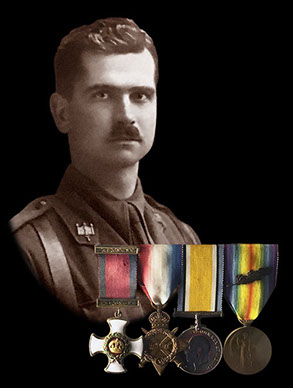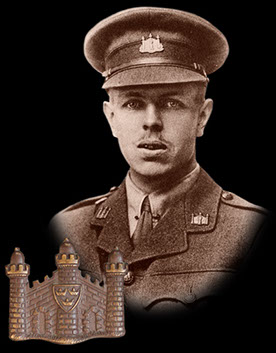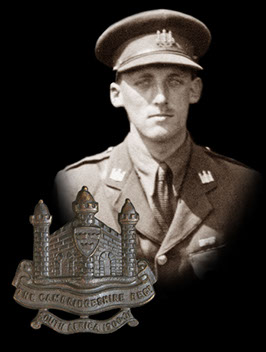
Who Were
The Cambs
The Cambs
at War
1/1st Btn 1914-1919
1914 - 1/1st Overview
1915 - 1/1st Overview
1915 - St Eloi
1915 - Fosse Wood
1916 - 1/1st Overview
1916 - The Schwaben
1916 - St Pierre Divion
1917 - 1/1st Overview
1917 - St Julien
Insignia, Medals & Books
Remembering The Cambs
Biographies
About Us &
This Site
The Cambridgeshires & the German Spring Offensive - 21st to 30th March 1918. Part 1
21st March
When the Germans launched their Spring Offensive on the Somme on a foggy March 21st 1918 their rapid bombardment and infiltration tactics with storm troops soon overran the lightly held British outpost line.
Waiting in reserve was the whole of the 39th Division, including the 1/1st Cambridgeshires in 118th Brigade. At 5pm that evening the Cambs were ordered forward to Longavesnes to help dig a switch line with an attack expected the following morning.
22nd & 23rd March
By morning of March 22nd a good line with support trenches had been dug and retreating troops from the front line were making their way into this line. By midday the Cambs Regt found themselves in the front line of active resistance in that part of the German attack, which had the goal of taking the important town of Amiens.
The position was a good one, with a reasonable field of fire, as the enemy soon discovered, wrote Major (later Lt-Col) Muirhead Collins Clayton DSO in the battalion history. By 5.30pm the commanding officer, Lt-Col Edward T Saint was told the 117th Brigade on the left was being forced back and the Cambs Regt should soon conform. As they moved away from their trenches, the German fire quickened and 26-year-old Capt Edmund Beale was killed by a sniper. They soon found their colleagues from the Black Watch and Cheshire Regt in the so-called Green Line, where the trenches were only six inches deep in places. The Cambs took up a support position behind the Green Line, but by daybreak on March 23rd B and D Companies were in close support ready to make a counter attack.
With troops falling back on the flanks, the Cambs were ordered to fight a rearguard action to cover the withdrawal of 39th Division. D Company were soon fighting off the enemy, but Germans were working round their left flank, so the Company had to withdraw around the village of Templeux. The company commander, Capt Edmund Kemplen, aged 21, was wounded along with Lt Francis Clayton (brother of M C Clayton). Soon D Company passed through A Company, who took up the rearguard fighting, along with C Company.
By midday they had withdrawn through 116th Brigade to Bussu and then marched back to the River Somme at Halle where the 118th Brigade was creating a new defensive line, along with other troops either side of the river.
24th & 25th March
By March 24th the Germans were still advancing in strength north of the River Somme and were engaged by the Cambs Regt with machine gun and rifle fire. A lack of available British artillery meant large groups of Germans moved forward relatively easily.
On March 25th, continuous firing took place on the right flank of the Cambs Regt, and the Germans crossed the Somme Canal near Eterpigny and captured the Le Maisonette Ridge on their right. C Company were in Biaches, and A Company were sent to cover them and the flank. By evening the situation was more serious because the 66th Division had withdrawn and the companies in Biaches were being attacked by Germans who had crossed the canel.
The men of B Company were in danger of being cut off as they were attacked on both flanks and almost surrounded. RSM Basil Matthews who had gone up to assist was wounded. By 10pm the Cambs were ordered to withdraw to Herbecourt, three miles away, with A Company acting as the rearguard.
26th March
By 4am on March 26th the Battalion was in a new line at Herbecourt, but by 7.15am the line on the right gave way and Lt-Col Saint and Capt Eric Wood MC & Bar worked hard to bring some order to the situation and keep the Battalion fighting as an organised unit. Small parties from the companies became separated from their comrades and some spent several days fighting with other units before rejoining their own battalion.
As Clayton wrote in the battalion history, March 26th was one of the most trying days experienced by the Cambridgeshires during the whole campaign. Clayton also paid tribute to the work of Lewis Gunners like L/Cpl Walter Muffett DCM and Pte Walter Bonnett, who took up positions with a store of ammunition and waited for the oncoming hordes of Germans.
Bonnett would be awarded the Distinguished Conduct Medal: For conspicuous gallantry and devotion to duty. All through an operation marked by a prolonged period of adverse circumstances, his never-failing cheerfulness and endurance were a fine example to his comrades. On one occasion he rushed an enemy machine gun position with the greatest courage, single-handedly putting the gun out of action and bringing back a prisoner. This gallant action was carried out with a dash that was the admiration of all who witnessed it.
By midnight another counter-attack was called for to prevent the enemy endangering the line at Framerville; it proved successful in holding the German advance. 2nd Lt William Chapman, who had been commissioned from the ranks of the Norfolk Regt in 1917 and was acting as the Battalion’s liaison officer with 117th Brigade, was killed.
Major Harry Few, of Willingham, recalled in the 1930s: I think it was midnight March 25th or 26th that Hollis (Lt Charles Harold ‘Tommy’ Hollis, attached from East Surrey Rgt) and I eventually rejoined the battalion after a 15 hours tramp from Amiens. We found the three brigades functioning together a little west of, I believe, Proyart.

The Cambs CO, Lt Col Saint, was awarded the DSO for his command during March 1918.

Capt Beale, KiA afternoon of March 22nd.


Walter Bonnett DCM from Bury St Edmunds

This site went live on the 14th February 2015 to mark 100 years since the 1/1st Cambs went off to war.
WE WILL REMEMBER THEM
Email us: cambsregt@gmail.com
Copyright 2015, 2016, 2017, 2018, 2019 by Felix Jackson. The information and images on this site should not be reproduced without prior permission.